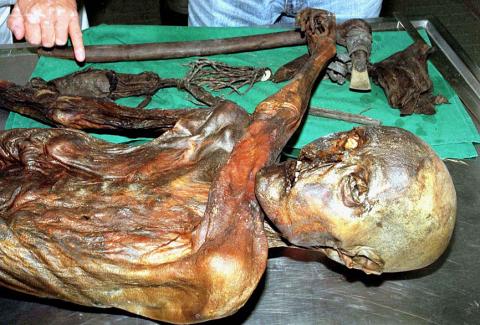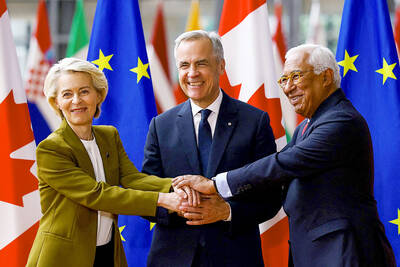Scientists examining the remains of “Otzi,” Italy’s prehistoric iceman who roamed the Alps about 5,300 years ago, yesterday said they have isolated what are believed to be the oldest traces of human blood ever found.
The German and Italian scientists said they used an atomic force microscope to examine tissue sections from a wound caused by an arrow that killed the Copper Age man, who was found frozen in a glacier, and from a laceration on his right hand.
“They really looked similar to modern-day blood samples,” said Albert Zink, 46, the German head of the Institute for Mummies and the Iceman at the European Academy in Bolzano, the capital of Italy’s German-speaking Alto-Adige region.

Photo: Reuters
“So far, this is the clearest evidence of the oldest blood cells,” he said by telephone, adding that the new technique might now be used to examine mummies from Egypt.
The studies were carried out in conjunction with the Center for Smart Interfaces at Darmstadt Technical University in Germany and the Center for Nano Sciences in Munich.
Over the last two decades, scientists have collected data from the stomach, bowels and teeth of the well-preserved man, who was found protruding out of a glacier by German climbers in 1991 in the Tyrolean Alps on the Austrian-Italian border.
Otzi, whose nickname derives from the German word for the area where he was found, had brown hair and type-O blood and was believed to be 45 when he was felled by an arrow while climbing the high mountains about 5,300 years ago.
The nanotechnology instrument used by Zink and his team scans the surface of the tissue sections using a very fine probe, the scientists said in a summary of their report.
As the probe moves over the surface, sensors measure every tiny deflection of the probe, line by line and point by point, building up a three-dimensional image.
Zink, an anthropologist, said the red blood cells his team found had a classic doughnut shape seen in healthy people today.
“It is very interesting to see that the red blood cells can last for such a long time,” he said.
“This will also open up possibilities for forensic science and may help lead to a more precise determination of the age of blood spots in crime investigations,” he added.
Earlier this year, the scientists made the first complete genome-sequencing on Otzi, determining that the man had a predisposition for cardiovascular diseases and brown eyes that betrayed possible near-Eastern origins.
Otzi had lactose intolerance that was common among Neolithic agrarian societies and was also the first known carrier of Lyme disease, a bacterial infection spread by ticks.
Examination of the wound where the arrow entered Otzi’s back identified fibrin, a protein involved in the clotting of blood, a summary of the report said.
Because fibrin is present in fresh wounds and then decays, this appears to show that the hunter died quickly rather than after a few days as had been previously thought, it said.
Zink carried out his research with Marek Janko and Robert Stark, professors of material sciences at the Center for Nano Sciences in Munich and Italian colleagues in Bolzano.
To be certain that the specimens they were examining were blood and not pollen, the scientists used a second analytical method known as the Raman spectroscopy method.
In that method, a laser beam illuminates a tissue sample and analysis of the spectrum of the scattered light permits the identification of various molecules.
Zink said he and his colleagues hope to carry out further analysis on Otzi’s enzymes, proteins and immune system.
“We hope we can make good progress in this area too,” he said.
The complete results will be published by Britain’s Journal of the Royal Society Interface.

‘SHORTSIGHTED’: Using aid as leverage is punitive, would not be regarded well among Pacific Island nations and would further open the door for China, an academic said New Zealand has suspended millions of dollars in budget funding to the Cook Islands, it said yesterday, as the relationship between the two constitutionally linked countries continues to deteriorate amid the island group’s deepening ties with China. A spokesperson for New Zealand Minister of Foreign Affairs Winston Peters said in a statement that New Zealand early this month decided to suspend payment of NZ$18.2 million (US$11 million) in core sector support funding for this year and next year as it “relies on a high trust bilateral relationship.” New Zealand and Australia have become increasingly cautious about China’s growing presence in the Pacific

The team behind the long-awaited Vera Rubin Observatory in Chile yesterday published their first images, revealing breathtaking views of star-forming regions as well as distant galaxies. More than two decades in the making, the giant US-funded telescope sits perched at the summit of Cerro Pachon in central Chile, where dark skies and dry air provide ideal conditions for observing the cosmos. One of the debut images is a composite of 678 exposures taken over just seven hours, capturing the Trifid Nebula and the Lagoon Nebula — both several thousand light-years from Earth — glowing in vivid pinks against orange-red backdrops. The new image

ESPIONAGE: The British government’s decision on the proposed embassy hinges on the security of underground data cables, a former diplomat has said A US intervention over China’s proposed new embassy in London has thrown a potential resolution “up in the air,” campaigners have said, amid concerns over the site’s proximity to a sensitive hub of critical communication cables. The furor over a new “super-embassy” on the edge of London’s financial district was reignited last week when the White House said it was “deeply concerned” over potential Chinese access to “the sensitive communications of one of our closest allies.” The Dutch parliament has also raised concerns about Beijing’s ideal location of Royal Mint Court, on the edge of the City of London, which has so

Canada and the EU on Monday signed a defense and security pact as the transatlantic partners seek to better confront Russia, with worries over Washington’s reliability under US President Donald Trump. The deal was announced after a summit in Brussels between Canadian Prime Minister Mark Carney and European Commission President Ursula von der Leyen and European Council President Antonio Costa. “While NATO remains the cornerstone of our collective defense, this partnership will allow us to strengthen our preparedness ... to invest more and to invest smarter,” Costa told a news conference. “It opens new opportunities for companies on both sides of the